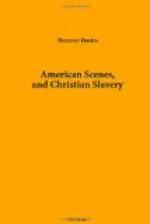Magazines and Periodicals 29,822 numbers.
Newspapers 25,390[1]
"
Serial Publications 30,826
"
Works of Fiction 48,961
" !
[Footnote 1: Besides an immense quantity sent direct per mail!]
It is estimated that the people of the United States, at the present time, support 1,200 newspapers. There being no stamp-duty, no duty on paper, and none on advertisements, the yearly cost of a daily paper, such as the New York Tribune for instance, is only 5 dollars, or one guinea. The price of a single copy of such papers is only 2 cents, or one penny; and many papers are only one cent, or a half-penny per copy.
4. Its Church Accommodation.—By the close of the year 1845 the voluntary principle, without any governmental or municipal aid whatever, had provided the following places of worship:—
Presbyterian 12 New Jerusalem 1
Methodist Episcopal 12 Universalist 1
Roman Catholic 7 Second Advent 1
Baptist 5 Mormons 1
Lutheran 5 Friends 1
Protestant Episcopal 4 Congregational 1
“Christian Disciples” 4 Restorationists
1
Methodist Protestants 3 United Brethren 1
Jewish 2 “Christians”
1
Welsh 2
German Reformed 2 Total 67
This number of places of worship, at an average of 600 persons to each, would afford accommodation for nearly two-thirds of what the entire population was at that time; and surely two-thirds of any community is quite as large a proportion as can, under the most favourable circumstances, be expected to attend places of worship at any given time. Behold, then, the strength and efficiency of the voluntary principle! This young city, with all its wants, is far better furnished with places of worship than the generality of commercial and manufacturing towns in England.
Dr. Reed visited Cincinnati in 1834. He gives the population at that time at 30,000, and the places of worship as follows. I insert them that you may see at a glance what the voluntary principle did in the eleven years that followed.
Presbyterian 6 Campbellite Baptists
1
Methodist 4 Jews
1
Baptist 2 —
Episcopalian 2 Total in 1834 21
German Lutheran 2 Do. in 1845 67
Unitarian 1 —
Roman Catholic 1 Increase 46
Swedes 1
5. Its Future Prospects.—The author of “Cincinnati in 1841” says, “I venture the prediction that within 100 years from this time Cincinnati will be the greatest city in America, and by the year of our Lord 2,000 the greatest city in the world.” Our cousin here uses the superlative degree when the comparative would be more appropriate. Deduct 80 or 90 per cent, from this calculation, and you still leave before this city a bright prospect of future greatness.




